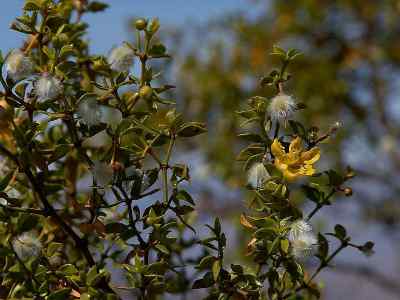Medical Uses of Creosote Bush
Creosote Bush Larrea tridentata has historical uses by Native Americans for the treatment of a number of illnesses. These maladies include chicken pox, dysmenorrhea, sexually transmitted diseases, snake bites and tuberculosis. Creosote Bush is still used in Mexico even today.
Creosote Bush can be found in the Mojave, Sonoran, and Chihuahuan Deserts of western US and extends into other portions of California, Arizona, Nevada, Utah, New Mexico and even into the Western reaches of Texas. It can also be found in parts of Mexico.
 Creosote Bushes can grow to over 10 feet tall, but is usually significantly smaller. Creosote Bush has small waxy leaves that retain water. The plant is very hardy and can survive for a couple of years without any rainfall. The normally green leaves can turn brown during extended droughts. Despite outward appearances the leaves, although brown are not dead.
Creosote Bushes can grow to over 10 feet tall, but is usually significantly smaller. Creosote Bush has small waxy leaves that retain water. The plant is very hardy and can survive for a couple of years without any rainfall. The normally green leaves can turn brown during extended droughts. Despite outward appearances the leaves, although brown are not dead.
The leaves are only a half inch or less in length and have a greenish-yellow color. The leaves have a unique characteristic in that they are always produced in pairs on opposite sides of the stem.
The Creosote Bush's yellow, 1 inch long flowers are produced from late winter to late summer. The flowers produce a fuzzy white seedpod.
The FDA and Health Canada have both issued warnings against using the leaves of this plant due to possible health problems such as damage to the liver and kidneys.
Uses:
Creosote Bush has antimicrobial properties. This property has led to a poultice of the leaves being used on cuts and bacterial or fungal infections.
Nordihydroguaiaretic acid is found in the plant and there are studies that conflict on whether it can inhibit cancerous growth or actually have detrimental toxic effects.
A decoction of the leaves was used to treat diarrhea and stomach troubles.
Young twigs were used to treat toothache. Native Americans would heat the shoot tips of this plant and dripped them into tooth cavities to treat toothache.
A tea made from the leaves is used as an expectorant and pulmonary antiseptic. It is supposed to help lower cholesterol.
A decoction made from dried root is used orally to fight diabetes.
An interesting side note is that the Creosote Bush can live to be 10,000 years old!!! WOW!
Creosote Bush can be found in the Mojave, Sonoran, and Chihuahuan Deserts of western US and extends into other portions of California, Arizona, Nevada, Utah, New Mexico and even into the Western reaches of Texas. It can also be found in parts of Mexico.

The leaves are only a half inch or less in length and have a greenish-yellow color. The leaves have a unique characteristic in that they are always produced in pairs on opposite sides of the stem.
The Creosote Bush's yellow, 1 inch long flowers are produced from late winter to late summer. The flowers produce a fuzzy white seedpod.
The FDA and Health Canada have both issued warnings against using the leaves of this plant due to possible health problems such as damage to the liver and kidneys.
Creosote Bush has antimicrobial properties. This property has led to a poultice of the leaves being used on cuts and bacterial or fungal infections.
Nordihydroguaiaretic acid is found in the plant and there are studies that conflict on whether it can inhibit cancerous growth or actually have detrimental toxic effects.
A decoction of the leaves was used to treat diarrhea and stomach troubles.
Young twigs were used to treat toothache. Native Americans would heat the shoot tips of this plant and dripped them into tooth cavities to treat toothache.
A tea made from the leaves is used as an expectorant and pulmonary antiseptic. It is supposed to help lower cholesterol.
A decoction made from dried root is used orally to fight diabetes.
An interesting side note is that the Creosote Bush can live to be 10,000 years old!!! WOW!
